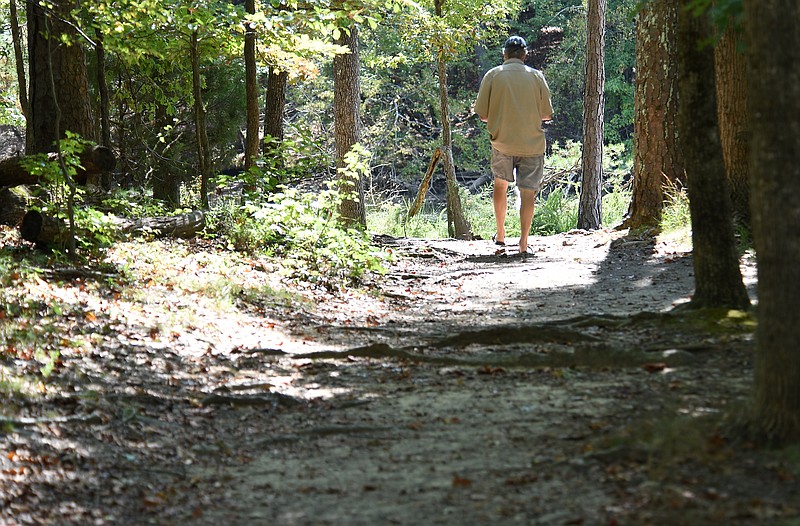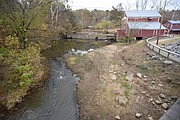Despite a splash of rain Monday, state climatologists say many Southeast Tennessee counties have plunged into an extreme drought as weeks of dry conditions have left the Chattanooga region 4-10 inches behind in rainfall for the past six months.
"Moderate to severe levels of drought are now being experienced across the majority of the state," Tennessee Climate Office officials said in a statement. "Except for small pockets along the Tennessee-Kentucky border, we're seeing monthly rainfall totals of 1 inch or less for the state. Stream flow levels are continuing to drop, soils are drying and reports of impacts to agriculture are beginning to trickle in to condition monitoring observer reports."
Record dry conditions in September didn't improve going into October as nearly all of Tennessee now is experiencing drought conditions ranging from abnormally dry in the northeast part of the state to extreme drought in southern portions, including the Chattanooga region, according to the Climate Office in Johnson City.
(READ MORE: Low Mississippi River limits barges just as farmers want to move their crops downriver)
The rain that passed through the region Monday wasn't nearly enough, said Andrew Joyner, state climatologist.
"Unfortunately, the rainfall will be minimal for this event, less than a half-inch for Chattanooga, which is already 4-10 inches below normal for the past six months, depending on where you are in the Chattanooga area," Joyner said in an email.
Conditions might not degrade into exceptional drought unless dryness continues into November, he said.
"There's no rainfall predicted for at least the next seven days after this event," Joyner said. "I'd say we're increasingly concerned about wildfire, too. For the seasonal outlook, Southern Tennessee may be a bit wetter based on El Niño patterns, but it's premature to say for sure. There may be some level of drought that lingers in the area through the next few months."
Tennessee counties in extreme drought
— Bledsoe.
— Bradley.
— Chester.
— Franklin.
— Grundy.
— Hamilton.
— Hardin.
— Marion.
— McMinn.
— McNairy.
— Meigs.
— Rhea.
— Sequatchie.
— Wayne.
Source: Tennessee Climate Office.
The first frost in the region is forecast for Wednesday morning, when the thermometer is expected to dip to 31 degrees, according to the weather service. Fortunately, most farm crops have already been harvested, but homeowners might want to move more delicate plants inside, according to Haley Treadway, the agriculture and natural resources agent at the University of Tennessee Agricultural Extension Office in Hamilton County. Farmers are looking ahead to November with trepidation and hoping for a return to normal levels of rain, Treadway said.
The majority of seed planting for fall crops, such as hay and cool weather pasture grasses, which provide winter food for livestock, were planted between Aug. 15 and Oct. 1, Treadway said. August was wetter than usual, so those crops started off good, but September dried out completely.
Only 0.13 inches of rain fell in Chattanooga in September, less than 3.1% of the normal precipitation totals in September and the lowest total rainfall for any month of September since 1919. September 2023 was the third driest September on record in Chattanooga.
This year's drought conditions follow six years in Chattanooga with above-average precipitation totals, including one of the wettest years on record in 2020, according to the National Weather Service. In the first eight months of 2023 ahead of the dry September, while hot, rainfall remained close to normal in Chattanooga.
As the rainfall deficit in the region deepened to 4-10 inches, farmers started to notice, Treadway said.
"I've talk to a couple, and they were talking about how their grass growth is limited, so much so that they can visibly notice, compared to when we had a wet early spring and summer," Treadway said by phone. "I've heard from some that this was an amazing year for growing grass, then we kind of hit the brakes. Although fall is known to be a drier time of year, this one's dryness is definitely more significant than what we generally experience."
Hay and fall grass crops are important as feed for grazing livestock going into the winter months, she said. If livestock farmers can't grow enough hay and grass, they have to buy it, and that drives up beef prices.
Additionally, homeowners should take steps now to prevent damage to at-risk plants and trees from the drought or this week's threat of frost for plants that aren't tolerant of cold, Treadway said.
(READ MORE: As Earth warms, more 'flash droughts' suck soil, plants dry)
"It's a good turning point in the season for any plants that are more sensitive to prepare to bring them inside or to prepare to let them go for fall and winter," she said.
Prized trees and landscape plants can suffer damage from prolonged drought. Now is the time to take steps to reduce the effect, Treadway said.
"If they have landscape plants or they have a beloved tree, and they've never had to water it before, if possible, keep irrigating them until they're fully dormant," she said.
Local 3 Weather meteorologist Cedric Haynes noted in his Monday midday report that a record high 85 degrees was reached Saturday in Chattanooga, but the cool air coming Wednesday will be the start of a longer, cooler spell.
Contact Ben Benton at bbenton@timesfreepress.com or 423-757-6569.

